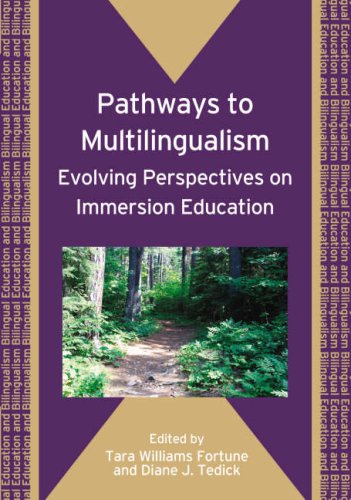

Most ebook files are in PDF format, so you can easily read them using various software such as Foxit Reader or directly on the Google Chrome browser.
Some ebook files are released by publishers in other formats such as .awz, .mobi, .epub, .fb2, etc. You may need to install specific software to read these formats on mobile/PC, such as Calibre.
Please read the tutorial at this link: https://ebookbell.com/faq
We offer FREE conversion to the popular formats you request; however, this may take some time. Therefore, right after payment, please email us, and we will try to provide the service as quickly as possible.
For some exceptional file formats or broken links (if any), please refrain from opening any disputes. Instead, email us first, and we will try to assist within a maximum of 6 hours.
EbookBell Team

4.1
60 reviews
ISBN 10: 1847690351
ISBN 13: 9781847690357
Author: Dr Tara Williams Fortune, Dr Diane J Tedick
Immersion education serves as a highly successful pathway to multilingualism. This volume focuses on the evolution of perspectives and practices within language immersion education and showcases an international roster of scholars who offer theoretical perspectives, research reviews and empirical studies on teaching, learning and language development in immersion programs. This collection of studies and discussions represents three branches of immersion education, foreign language (“one-way”), bilingual (“two-way”) and indigenous immersion programs. Each branch has its unique situational dynamics to address, and such dynamics must be carefully considered particularly in the interpretation of research findings. Nevertheless, the volume’s co-editors argue that much can be learned from research and practices carried out in closely related immersion settings that experience similar challenges related to the delicate balance between language and content. This volume presents an opportunity for thoughtful cross-context dialogue and knowledge exchange.
Chapter 1 One-Way, Two-Way and Indigenous Immersion: A Call for Cross-Fertilization
Chapter 2 Dual Language in the Global Village
Part 1 Evolving Perspectives on Immersion Pedagogy
Chapter 3 Paying Attention to Language: Literacy, Language and Academic Achievement
Chapter 4 Integrated Language and Content Teaching: Insights from the Immersion Classroom
Chapter 5 Diversity Up Close: Building Alternative Discourses in the Two-Way Immersion Classroom
Part 2 Evolving Perspectives on Language Development in Immersion Classrooms
Chapter 6 Lexical Learning Through a Multitask Activity: The Role of Repetition
Chapter 7 Instructional Counterbalance in Immersion Pedagogy
Chapter 8 Teacher Strategies for Second Language Production in Immersion Kindergarten in Finland
Part 3 Evolving Perspectives on Social Context and its Impact on Immersion Programs
Chapter 9 Language Development and Academic Achievement in Two-Way Immersion Programs
Chapter 10 Developing a Critical Awareness of Language Diversity in Immersion
Chapter 11 Restoring Aboriginal Languages: Immersion and Intensive Language Program Models in Canada
Chapter 12 Late Immersion in Hong Kong: Still Stressed or Making Progress?
Synthesis for the Volume
Chapter 13 Concluding Thoughts: Does the Immersion Pathway Lead to Multilingualism?
pathways to multilingualism
raise the bar pathways to multilingualism
multilingualism benefits in education
pathways example
pathways to biliteracy
pathways to biliteracy lausd
Tags: Dr Tara Williams Fortune, Dr Diane J Tedick, Pathways, Multilingualism